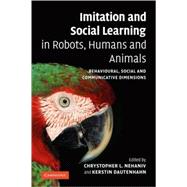
Note: Supplemental materials are not guaranteed with Rental or Used book purchases.
Purchase Benefits
What is included with this book?
| Introduction: The constructive interdisciplinary viewpoint for understanding mechanisms and models of imitation and social learning | |
| Correspondence Problems and Mechanisms | |
| Imitation: thoughts about theories | |
| Nine billion correspondence problems | |
| Challenges and issues faced in building a framework for conducting research in learning from observation | |
| Mirroring and 'Mind-Reading' | |
| A neural architecture for imitation and intentional relations | |
| Simulation theory of understanding others: a robotics perspective | |
| Mirrors and matchings: imitation from the perspective of mirror-self-recognition and the parietal region's involvement in both | |
| What to Imitate | |
| The question of 'what to imitate': inferring goals and intentions from demonstrations | |
| Learning of gestures by imitation in a humanoid robot | |
| The dynamic emergence of categories through imitation | |
| Development and Embodiment | |
| Copying strategies by people with autistic spectrum disorder: why only imitation leads to social cognitive development Justin | |
| A bayesian model of imitation in infants and robots | |
| Solving the correspondence problem in robotic imitation across embodiments: synchrony, perception and culture in artefacts Aris Alissandrakis | |
| Synchrony and Turn-Taking as Communicative Mechanisms | |
| How to build an imitator? | |
| Simulated turn-taking and development of styles of motion | |
| Bullying behaviour, empathy and imitation: an attempted synthesis | |
| Why Imitate? Motivations | |
| Multiple motivations for imitation in infancy | |
| The progress drive hypothesis: an interpretation of early imitation | |
| Social Feedback | |
| Training behaviour by imitation: from parrots to people ... to robots? | |
| Task learning through imitation and human-robot interaction | |
| The Ecological Context | |
| Emulation learning: the integration of technical and social cognition | |
| Mimicry as deceptive resemblance: beyond the one-trick ponies | |
| Table of Contents provided by Publisher. All Rights Reserved. |
The New copy of this book will include any supplemental materials advertised. Please check the title of the book to determine if it should include any access cards, study guides, lab manuals, CDs, etc.
The Used, Rental and eBook copies of this book are not guaranteed to include any supplemental materials. Typically, only the book itself is included. This is true even if the title states it includes any access cards, study guides, lab manuals, CDs, etc.